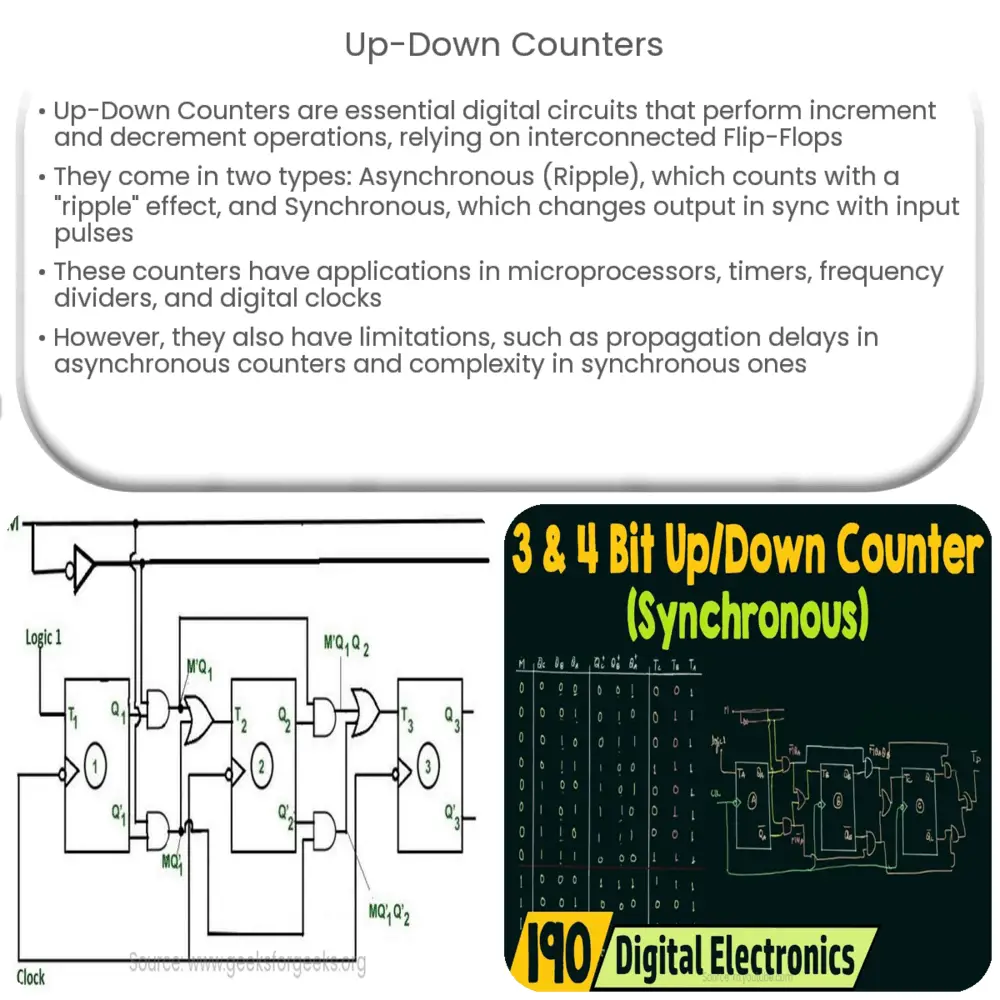Explore the versatile world of Up-Down Counters, their types, applications, and limitations in digital systems, in our comprehensive guide.

Introduction to Up-Down Counters
An Up-Down Counter, as the name suggests, is a versatile digital circuit that is used in computers to perform both increment (count up) and decrement (count down) operations. This circuit holds a special place in digital systems because of its core functionality in performing various counting tasks.
Components of Up-Down Counters
The primary components of an Up-Down Counter are a series of Flip-Flops, which are sequential logic circuits with two stable states. These Flip-Flops are interconnected in such a way that the output of one becomes the input to the next, creating a ripple effect. The change in the state of a Flip-Flop, either from 0 to 1 or vice versa, signifies a count.
- Up Counter: An Up Counter is a simple counter circuit which counts upwards. When clock pulses are given, the counter increments the binary number each time a pulse is detected.
- Down Counter: In contrast, a Down Counter is a counter circuit that counts in a descending order. It decrements the binary number each time a pulse is detected.
Types of Up-Down Counters
Based on the sequence in which they count, Up-Down Counters can be classified into two main types:
- Asynchronous (Ripple) Up-Down Counters: The most basic type of counter, where the first Flip-Flop is clocked by an external clock pulse, and then each subsequent Flip-Flop is clocked by the output of the previous one. This creates a “ripple” effect, hence the name.
- Synchronous Up-Down Counters: In these counters, all the Flip-Flops are simultaneously triggered by the input pulses. Thus, the output changes synchronously with the input pulse. Synchronous counters are generally used when fast counting speeds are required, as they do not have the time delay issues seen in asynchronous counters.
While these counters find their application in a vast array of digital systems, the core principle of operation remains the same: a series of interconnected Flip-Flops, incrementing or decrementing the count based on the input pulses.
Applications of Up-Down Counters
Up-Down counters are used extensively in a variety of digital systems. Some of the most common applications include:
- Microprocessors: In microprocessors, Up-Down Counters are used for program execution, where they act as Program Counters, incrementing or decrementing to keep track of the address of the instruction to be executed next.
- Timers: Up-Down Counters can be utilized to create digital timers, which can count upwards (stopwatch) or downwards (countdown timer).
- Frequency Dividers: By adding certain circuit components, an Up-Down Counter can be made to function as a frequency divider, where the output frequency is a division of the input frequency.
- Digital Clocks: Digital clocks use Up-Down Counters to keep track of time, counting up to 60 seconds and then resetting to zero.
Up-Down Counter Limitations
While Up-Down Counters are highly useful, they do have some limitations. For instance, asynchronous counters can have propagation delays due to the ripple effect. This means that a change in state in one flip-flop can take some time to propagate through to subsequent flip-flops, resulting in a delay. On the other hand, synchronous counters, despite their speed, are more complex and require more circuit elements, increasing their overall cost.
Conclusion
In conclusion, Up-Down Counters are fundamental elements of digital circuits, handling various counting operations in a wide range of digital systems. Whether it’s keeping track of instructions in a microprocessor, marking time in a digital clock, or serving as a frequency divider, the functionality of these counters is indispensable. Despite certain limitations, the practical applications of Up-Down Counters in the digital world are vast and continue to grow with advancements in technology.

